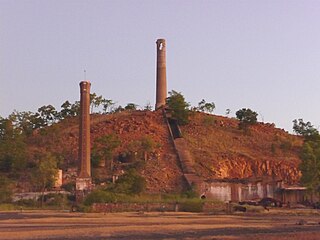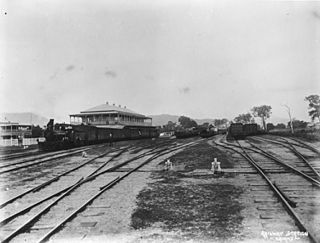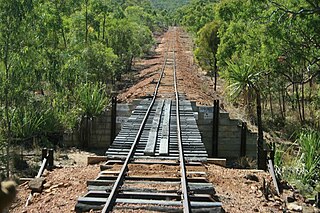
Chillagoe-Mungana Caves is a national park in Chillagoe, Shire of Mareeba, Queensland, Australia.

Chillagoe is a rural town and locality in the Shire of Mareeba, Queensland, Australia. In the 2016 census the locality of Chillagoe had a population of 251 people.

Mount Garnet is a rural town and locality in the Tablelands Region, Queensland, Australia. In the 2016 census, Mount Garnet had a population of 430 people.

The Savannahlander is an Australian passenger train service that operates in Far North Queensland. It travels on the Tablelands railway line and the Etheridge railway line from the coastal city of Cairns to Forsayth.

Forsayth is a rural town and locality in the Shire of Etheridge, Queensland, Australia. In the 2016 census, Forsayth had a population of 129 people.

The Chillagoe smelters is a heritage-listed refinery at Chillagoe-Mungana Caves National Park, Mareeba Mining District, Chillagoe, Shire of Mareeba, Queensland, Australia. It operated in the early 1900s. It is also known as Chillagoe State Smelters. It was added to the Queensland Heritage Register on 21 October 1992.

Queensland's railway construction commenced in 1864, with the turning of the first sod of the Main Line by Lady Diamantina Bowen, the wife of Queensland's first governor Sir George Bowen at Ipswich, Queensland, Australia. A narrow gauge of 3 ft 6 in was selected due to cost savings in providing a rail link to Toowoomba. Despite being built with bridges wide enough for standard gauge, and the fact that most other lines did not require heavy earthworks, the gauge remained the Queensland system norm.

The Tablelands railway line is a railway line in North Queensland, Australia. It was opened in a series of sections between 1887 and 1916. It commences at Cairns and at its maximum extent, reached Ravenshoe at the southern end of the Atherton Tableland. The rail system served by this line was unusual for Queensland in that the majority of lines that connected to it were built by private companies and later purchased by the Queensland Government.

Lappa is a former railway town on the western side of the Atherton Tablelands near Petford in the Shire of Mareeba in Far North Queensland, Australia.

OK Mine & Smelter is a heritage-listed mine at Kitoba Holding, Bellevue, Shire of Mareeba, Queensland, Australia. It was built from 1902 to 1942. It was added to the Queensland Heritage Register on 2 October 1996.

Mungana Archaeological Area is a heritage-listed former mining town at Mungana, Chillagoe, Shire of Mareeba, Queensland, Australia.It is also known as Mungana Prospect, Old Mungana Township, Mungana Township, Lady Jane Mine, Eclipse Limeworks and Cemetery, and Girofla Mine. It was added to the Queensland Heritage Register on 11 December 2008.
Einasleigh Copper Mine and Smelter is a heritage-listed mine at Daintree Road, Einasleigh, Shire of Etheridge, Queensland, Australia. It was built from 1867 to 1922. It is also known as Lynd Copper Mine and New Einasleigh Copper Mine. It was added to the Queensland Heritage Register on 11 December 2006.

Einasleigh Hotel is a heritage-listed hotel at Daintree Street, Einasleigh, Shire of Etheridge, Queensland, Australia. It was built from 1908 to 1909. It is also known as Central Hotel. It was added to the Queensland Heritage Register on 6 February 2006.

Station Master's Residence is a heritage-listed detached house at Railway Reserve, Einasleigh, Shire of Etheridge, Queensland, Australia. It was built c. 1909. It was added to the Queensland Heritage Register on 21 October 1992.

Etheridge railway line is a heritage-listed railway line between Mount Surprise and Forsayth, both in the Shire of Etheridge, Queensland, Australia. It includes Mount Surprise railway station, Einasleigh railway station, Wirra Wirra railway station and Forsayth railway station. Etheridge railway line was added to the Queensland Heritage Register on 16 February 2009.

Almaden is a rural town and locality in the Shire of Mareeba, Queensland, Australia. In the 2016 census, the locality of Almaden had a population of 71 people.
Station Master's Residence is a heritage-listed detached house at Fourth Street, Forsayth, Shire of Etheridge, Queensland, Australia. It was built c. 1910. It was added to the Queensland Heritage Register on 21 October 1992.

Quartz Hill Coach Change Station Site and Cemetery is a heritage-listed coach station in Mount Surprise, Shire of Etheridge, Queensland, Australia. It was built from 1888 to 1908. It was added to the Queensland Heritage Register on 4 July 2006.
Petford is a rural locality in the Shire of Mareeba, Queensland, Australia. In the 2016 census, Petford had a population of 32 people.
Ootann Road is a continuous 90.5 kilometres (56.2 mi) road route in the Mareeba and Tablelands local government areas of Queensland, Australia. It is a north-south link between the Burke Developmental Road and the Kennedy Highway, servicing a number of cattle grazing and production areas in northern Queensland. It is also part of the shortest route from the Chillagoe area to Hughenden.


















